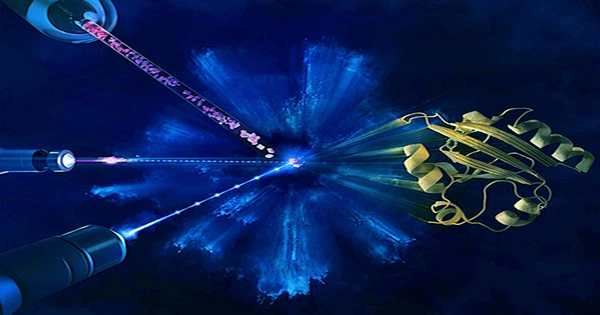The University of Strathclyde’s simulation of ice-cold electron beams may help shrink X-ray free-electron lasers (X-FELs) to a tiny fraction of their present dimensions.
X-FELs, also known as “engines of discovery,” transform the kinetic energy of an electron beam into strong photon bursts that extend down to hard X-ray wavelengths. For hot-dense matter research, resolving the structure of complex biomolecules for novel drugs, studying the properties of materials for next-generation microchips, and many other uses, X-FELs are employed.
Electron beams swinging along a route inside an undulator, a device with an alternating magnetic field, are at the center of FELs. The wiggling motion causes the electron beam to release bursts of photons, and at the radiation wavelength, a positive feedback effect causes the electron beam to form micro-bunches. As a result, the radiation strength increases exponentially along the undulator and intensifies.
Only if the electron beam is of good quality at relativistic energies can this self-organizing effect take place. Modern X-FELs, which can cost up to a billion pounds, are kilometer-scale, finely tuned machines that must satisfy the strict requirements for electron beam quality. As a result, there are very few X-FEL facilities in existence globally, and there are currently none in the UK.
A Plasma Wakefield Accelerator (PWFA) outfitted with the “Trojan horse” advanced electron injection technique known as plasma photocathode can generate electron beams 100,000 times brighter than the state-of-the-art, according to Strathclyde study that uses high-fidelity start-to-end simulations. This is because the distribution with minimal momentum spread results in extremely cold electron beams.
The PWFA also has an accelerating electric field that allows for the realization of the accelerator on a centimeter scale as opposed to the kilometer scales of conventional accelerators. This field has a capability of tens to hundreds of gigavolt-per-meter.
The research investigates the extraction, transportation, isolation, and injection of ultra-high brightness, ice-cold electron beams from plasma photocathode PWFA into an undulator without charge and quality loss; they do not “melt” or lose their coldness. The ultrahigh quality electron beam, when focused into an undulator, generates strong, coherent, laser-like photon pulses with pulse lengths in the attosecond (11018 of a second) range. In contrast to modern, kilometer-sized X-FEL machines, the complete system may have a spatial footprint of only a few tens of meters in addition to the extremely high quality of the electron and resulting photon pulses.
The three achievements made in the study, according to the researchers, may pave the way for the development of ultra-compact X-FELs of the next iteration. The research, which is a component of the extensive UK X-FEL project, was published in the journal Nature Communications.
Leading post-doctoral scholar for the study and Research Associate at Strathclyde’s Department of Physics, Fahim Habib, stated, “The potential for ultra-compact plasma-X-FELs built on this plan is astounding. Our findings are significant first steps, but we still have a long way to go before we can actually test the approach.”
The project’s director, Professor Bernhard Hidding of Strathclyde, said: “At our strategic collaborator Stanford’s SLAC FACET facility, as part of our Trojan Horse collaboration, the first experimental proof of plasma photocathode injection in PWFA was attained. We now hope to fully realize the scheme’s promise in terms of beam quality and stability with our program at the successor facility SLAC FACET-II.”
Reader at the School of Physics, Dr. Brian McNeil, stated, “The primary performance criterion for free-electron lasers is brightness. Plasmas may be able to produce electron beams that are as bright and brief as those in our computational study, which could have a significant effect on photon science.”
















